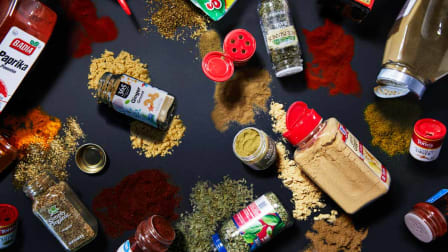Is Adobo Good for You?
Some brands of this Latino kitchen staple can be surprisingly high in sodium

In many Latino kitchens, adobo seasoning isn’t just an ingredient—it’s a tradition, a flavor that connects generations of families. Growing up in Queens, New York, I remember watching my mother season meats with adobo, a Latin blend of spices—usually garlic powder, onion powder, paprika, black pepper, oregano, and cumin—and adding mashed garlic, salt, and oregano. It was her go-to for adding that perfect Dominican flavor that my dad, brothers, and I loved.
Adobo is also the special ingredient to the mouth-watering grilled meats and Ecuadorian dishes my father-in-law, Carlos Rodriguez, has been serving at family gatherings for decades. But this past summer, Carlos’ doctors found serious blockages in his arteries. He underwent quadruple bypass surgery and had to make changes to his diet that included significantly lowering his sodium intake. That meant rethinking his liberal use of adobo, which is loaded with sodium. “I changed my eating habits and also the salt intake. I don’t use adobo like I used to,” Carlos says.
What's In Your Adobo?
Recently, Consumer Reports tested various spices and spice mixes for heavy metals such as lead and arsenic. The good news? Neither of the two adobo products we tested—Goya Adobo All-Purpose Seasoning and Loisa Organic Adobo—contained concerning levels. However, their sodium content (as well as that in some other adobo mixes) may be a concern.
Goya’s adobo has 520 mg of sodium per ¼ teaspoon while Loisa’s adobo has 270 mg per ¼ teaspoon. That’s 22 and 12 percent, respectively, of the maximum daily limit.
That may not sound so bad, but adobo is a staple in many Latin dishes—such as yellow rice with pigeon peas, slow-cooked pork roast, stewed chicken, and stewed lamb—and an individual serving may contain more than ¼ teaspoon. Plus it’s not uncommon for adobo to be an ingredient in several dishes in a meal, so it’s easy to see how frequently using adobo could bump up your sodium intake to potentially unhealthy levels.

Photo: Luz Plasencia/Consumer Reports Photo: Luz Plasencia/Consumer Reports
Healthier Alternatives
For many Latino families, reducing salt doesn’t have to mean sacrificing flavor and their favorite traditional dishes.
Meals can still be rich and flavorful, supporting both cultural roots and heart health. You could use a lower-sodium or salt-free adobo mix. For example, Goya Adobo Light All-Purpose Seasoning has 50 percent less sodium than the original, and Loisa has a salt-free, zero-sodium version. But making your own adobo blend is easy and allows you to customize the mix to your taste, adding more or less of a particular flavor like garlic or cumin, Arevalo says.
Salt-Free Adobo Mix
1 tsp garlic powder
1 tsp onion powder
1 tsp ground paprika
1 tsp ground parsley
1 tsp ground oregano
½ tsp black pepper
1 tsp ground cumin
1 tsp ground coriander
1 tsp ground turmeric
Arevalo also says you can use other ingredients that evoke Latin flavors in your cooking. These include tomatoes, sweet peppers, chili peppers, fresh cilantro, fresh parsley, or any other combination of flavors that give your dishes more complexity than salt.
That’s the approach my father-in-law Carlos has taken. He continues to make delicious meals for himself and his wife and for family gatherings using a variety of spices and fresh herbs to reduce the salt and not the flavor. “I use a lot of garlic, parsley, and cilantro,” he says. “And I use a seasoning that contains about 17 ingredients and there’s no salt in there."
@consumerreports What’s really in your adobo? While it adds amazing flavor, some brands can pack a lot of sodium. Tap the link in our bio for the full details and a DIY recipe with a healthier twist. #foodtok #comidatiktok #healthyeating #adobo
♬ original sound - Consumer Reports




















